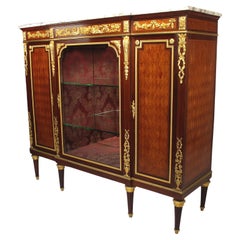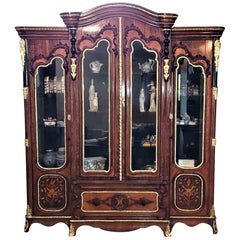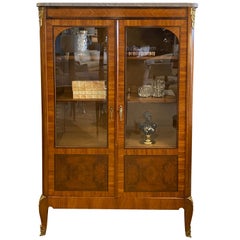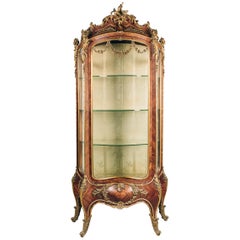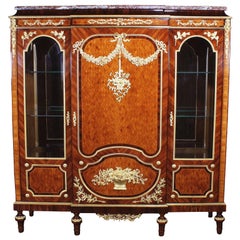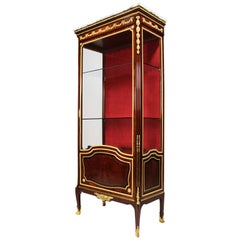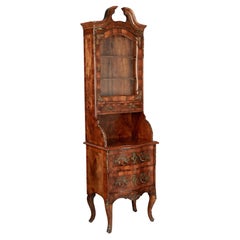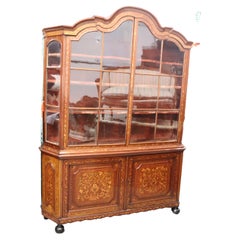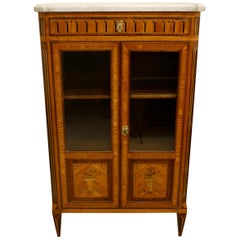Tulipwood Vitrines
to
9
Height
to
Width
to
Depth
to
20
6
27
11
9
1
1
18
9
7
6
488
1,495
917
802
291
27
24
2
1
1
27
27
27
2
1
1
Material: Tulipwood
French Louis XVI Style Ormolu Mounted & Tulipwood Vitrine Cabinet
Located in Los Angeles, CA
A Very Fine French 19th-20th Century Louis XVI Style Mahogany, Tulipwood and Ormolu-Mounted Parquetry Three-Door Vitrine Commode 'Meuble d'appui with a Brêche Violette Marble Top, attributed to François Linke (1855-1946). The interior of the vitrine with three glass shelves, lined with a burgundy broque fabric and a mirror backing, flanked by a pair of side doors, each fitted with a pair of mahogany...
Category
Early 1900s French Louis XVI Antique Tulipwood Vitrines
Materials
Marble, Ormolu, Bronze
$24,850 Sale Price
27% Off
Large 19 Century French Rococo or Neoclassical Revival Style Vitrine
By David Roentgen
Located in Dallas, TX
Stunning 19th century French Empire, neoclassical/Rococo Revival style Marquetry vitrine or display cabinet, of large proportions!!
A real statement piece!
Made of a fabulous variety of veneers, including kingwood, satinwood, tulipwood, harewood and walnut with quality classical ormolu mounts.
It has ebonized pillars in the Empire style, with walnut and exotic hardwood friezes in the Rococo style.
Double glass doors to middle section and single glass doors on either side.
The glass on the doors are framed in ormolu banding.
Floral Marquetry panels on front and parquetry on the sides.
The front central section is a pullout / pull-out drawers with gorgeous walnut frieze panel and original carved walnut knobs.
Scrolling pelmet on the top in 3 sections banded in ormolu beading.
Scrolling base with cabriolet feet and ormolu mounts on base.
Various ormolu mounts, floral mounts, mounts of Baachus and mounts of neoclassical female figures.
In 3 sections. with 2 side cabinets and large central section with 3 section pelmet, stunning piece!!!
The quality ormolu mounts are marked with the letter “R” and what appears to be “FR 678”.
We were originally of the belief that this piece might have been made at the very end of the 19th century, but having regard to the quality of workmanship throughout this piece we are of the opinion that it was most likely made in the third quarter of the 19th century, circa 1870 and by an obviously top quality Parisienne maker with a surname beginning with “R”.
It is definitely in the style of David Roentgen who was known for his Rococo/neoclassical styles.
David Roentgen, (born Aug. 11, 1743-died Feb. 12, 1807, Wiesbaden, Duchy of Nassau), cabinetmaker to Queen Marie-Antoinette of France; under his direction the family workshop at Neuwied (near Cologne), founded by his father, Abraham Roentgen, became perhaps the most-successful firm of furniture production in the 18th century.
After succeeding his father as head of the Neuwied workshop in 1772, Roentgen strove to broaden their clientele, an ambition that brought him first to Hamburg and ultimately to Paris (1774), where in 1779 he was spectacularly successful in selling his finest furniture to King Louis XVI of France for £3,300 to £4,000, an unprecedented sum for the time.
Appointed cabinetmaker to the queen, Roentgen was granted admission (1780) as maître-ébéniste (master cabinetmaker) to the trade corporation of Paris cabinetmakers, making it possible for him to keep in Paris a stock of the furniture manufactured at Neuwied. Thus he was able to compete with such great cabinetmakers as Jean-Henri Riesener and Adam Weisweiler, reputedly his former pupil at Neuwied. After his first visit to St. Petersburg, Empress Catherine II the Great bought huge quantities of his furniture; King Frederick William II of Prussia was also his client. When in 1795 the French Revolutionary armies threatened to cross the Rhine, Roentgen evacuated his establishment and moved his stock farther inland. Unfortunately, he lost everything in his Parisian salon and in his Neuwied workshop, both of which were sacked by Republican troops. He was crushed, despite his appointment as court furnisher to the king of Prussia. Although he never succeeded in starting production again, former apprentices of his whom he helped to establish in the German cities of Berlin (David Hacker...
Category
Mid-19th Century French Rococo Revival Antique Tulipwood Vitrines
Materials
Ormolu
$9,600 Sale Price
48% Off
Vitrine French 2 Door with Marble Top, Ormolu Mounts, Louis XV Styling
Located in Toronto, CA
A vitrine in the Louis XV French styling, with 2 glass doors and a marble top. The case is veneered in Walnut with tulip wood and rosewood and the ormolu mounts give it a formal char...
Category
20th Century French Louis XV Tulipwood Vitrines
Materials
Tulipwood, Walnut
Rare Louis XV Style Tulipwood Bome Vitrine by Maison Krieger, French, circa 1880
Located in Brighton, West Sussex
An important and extremely rare Louis XV style gilt bronze mounted bombe vitrine, firmly attributed to Maison Krieger.
The back of the mounts on the four cornice corners and the floral swags cast with the monogram LM possibly for Leon Message; an old, possibly original label on the back with ink inscription: '1181 (?), galbee vitrine, Lxv, bois Violette..101'.
This exceptional vitrine has a spreading pediment centred by a finely cast gilt bronze stylized acanthus, ‘C’-scroll and foliate cresting, above a glazed bombé central door and concave sides. The silk lined interior is fitted with adjustable shelves and the angles headed by superb gilt bronze figural espagnolettes with uplifted heads, plumes and ruffs. The lower galbée shaped section of the vitrine is mounted with foliate garlands and raised on cabriole legs with acanthus clasps and feet.
An almost identical vitrine of the same proportions, construction and design, stamped to the lockplate ‘Mon Krieger...
Category
Late 19th Century French Louis XV Antique Tulipwood Vitrines
Materials
Bronze
French 19th-20th Century Louis XVI Style Mahogany, Kingwood Parquetry Vitrine
Located in Los Angeles, CA
A very fine French 19th/20th century Louis XVI style mahogany, kingwood and tulipwood parquetry three-door vitrine with ormolu-mounted floral wreaths, ribbons, female masks and centr...
Category
Early 1900s French Louis XVI Antique Tulipwood Vitrines
Materials
Marble, Bronze
$37,950 Sale Price
20% Off
French Louis XV Style Belle Époque Mahogany & Ormolu-Mounted Vitrine Attr. Linke
Located in Los Angeles, CA
A very fine French Louis XV style Belle Époque mahogany and tulipwood ormolu-mounted vitrine cabinet with a Brêche violette marble top, attributed to François Linke (1855-1946). The ...
Category
Early 1900s French Louis XV Antique Tulipwood Vitrines
Materials
Marble, Bronze, Ormolu
$21,895 Sale Price
54% Off
Fine French 19th-20th Century Louis XV Style Ormolu-Mounted Tulipwood Vitrine
Located in Los Angeles, CA
A Fine French 19th-20th century Louis XV style ormolu-mounted tulipwood vitrine with marble top, in the manner of François Linke (1855-1946). The slender single door cabinet fitted w...
Category
Early 1900s French Louis XV Antique Tulipwood Vitrines
Materials
Bronze, Ormolu
$14,950 Sale Price
39% Off
French 19th Century Louis XVI St. Cabinet Vitrine Signed François Linke
Located in West Palm Beach, FL
A stunning and extremely high quality French 19th century Louis XVI st. Belle Époque period Kingwood, Tulipwood, ormolu and Brèche Polychrome de St. Bernard marble cabinet vitrine si...
Category
19th Century French Louis XVI Antique Tulipwood Vitrines
Materials
Marble, Ormolu
Rare Pair of 19th Century Marquetry Display Cabinets in the Louis XVI Style
By E. Kahn
Located in London, GB
A pair of Marquetry display cabinets
in the transitional manner
By Edmund Kahn of London & Paris
Constructed from kingwood, with tulipwood, bois satiné and harewood inlays; f...
Category
19th Century French Louis XVI Antique Tulipwood Vitrines
Materials
Ormolu
20th Century Magnificent French Louis XVI Style Display Cabinet
Located in Berlin, DE
20th century magnificent French Louis XVI style display cabinet
Bois-Satiné veneer, all-round surface-covering mirror veneer on wood. Upright rectangular and rounded, glazed on thre...
Category
20th Century Italian Louis XVI Tulipwood Vitrines
Materials
Glass, Mirror, Wood, Tulipwood
$3,745 Sale Price
20% Off
French 19th Century Louis XV Style Gilt Bronze-Mounted and Vernis Martin Vitrine
Located in Los Angeles, CA
A fine French 19th century Louis XV Style gilt bronze-mounted and "Vernis Martin" style bombé tulipwood veneered vitrine cabinet with a Breche d' Alep marble top. The serpentine fron...
Category
Late 19th Century French Louis XV Antique Tulipwood Vitrines
Materials
Marble, Bronze
$12,985 Sale Price
23% Off
Maison Krieger French Louis XVI Matched Kingwood Glass Display Cabinet Vitrine
Located in Forney, TX
A very fine quality French Louis XVI style gilt bronze ormolu mounted matched kingwood display cabinet / vitrine by the luxurious Parisian furniture maker Maison Krieger (1826-1910)
Exquisitely hand-crafted in France in the early 20th century, exceptionally executed in sophisticated King Louis 16th taste, having a dramatically veined marble top, over glazed glass front and side panels, opening to single glass shelf and mirrored back, over ribbed cabinet...
Category
Early 20th Century French Louis XVI Tulipwood Vitrines
Materials
Bronze
Antique English Victorian Inlaid Rosewood Console Vitrine Circa 1840's
Located in Los Angeles, CA
Antique English Victorian Inlaid Rosewood Console Vitrine Circa 1840's. With pen faux floral marquetry and gilt bronze mounts.
Age: 1800 - 1850
Furniture Style: Victorian (1830 - 1...
Category
1840s British Victorian Antique Tulipwood Vitrines
Materials
Bronze
19th Century French Ormolu-Mounted 'Vernis Martin' Vitrine
Located in Tarzana, CA
A stunning and unusual French 19th century Louis XV Style gilt bronze-mounted and "Vernis Martin" style bombé tulipwood veneered vitrine cabinet. The serpentine front door vitrine wi...
Category
19th Century French Antique Tulipwood Vitrines
Materials
Tulipwood
Fine French Belle Epoque 19th Century Vernis Martin Vitrine by Louis Majorelle
Located in Los Angeles, CA
A very fine French Belle Époque 19th century tulipwood and gilt bronze-mounted Vernis Martin decorated Vitrine by Louis Majorelle (French, 1859-1926). The single door case with a hand-painted board depicting a garden courting scene surmounted with ormolu wreaths and a banded frame. The top with a pierced gilt bronze gallery above an ormolu royal tassel trim flanked by a pair of female masks above crossed torches and flames, cross flutes, a tambourine, a pan flute, ribbons and a tassel. Raised of four cabriolet legs with corner ormolu wreaths and leaves ending with hooves, Paris, circa 1990.
The back bears the original Majorelle label that reads: "Louis Majorelle, Fabrique a Nancy, 3 Rue Girardel. Depot. 56 Rue de Paradis, Paris."
Louis-Jean-Sylvestre Majorelle, usually known simply as Louis Majorelle, (26 September 1859 – 15 January 1926) was a French decorator and furniture designer who manufactured his own designs, in the French tradition of the ébéniste. He was one of the outstanding designers of furniture in the Art Nouveau style, and after 1901 formally served as one of the vice-presidents of the École de Nancy.
The Majorelle firm's factory was designed by famous École de Nancy architect Lucien Weissenburger (1860 – 1929) and located at 6, rue du Vieil-Aître in the western part of Nancy. In the 1880s Majorelle turned out pastiches of Louis XV furniture styles...
Category
Early 1900s French Louis XV Antique Tulipwood Vitrines
Materials
Bronze, Ormolu
$26,850 Sale Price
23% Off
19th-20th Century Marquetry and Gilt-Bronze Mounted, François Linke Atrributed
Located in Los Angeles, CA
A fine French 19th-20th century kingwood and tulipwood marquetry and gilt-bronze mounted vitrine, in the manner of François Linke (1855-1946). The slender single door display cabinet with a red-velvet backing and bowed glass panels surmounted with acanthus and floral gilt-bronze mounts in the style of Léon Messagé (French, 1842-1901), the serpentine shaped front door with an ornate marquetry and ink colored panel depicting wreaths, ribbons and tied acantus leaves, all raised on four cabriolet legs ending with gilt-bronze paw-feet, Paris, circa 1900.
Linke was born on 17 June 1855 in the small village of Pankraz, in what is now the Czech Republic. Records show that Linke served an apprenticeship with the master cabinet maker, Neumann, which he completed in 1877. Linke’s work book or Arbeits-Buch records that he was in Vienna from July 1872 to October 1873 at the time of the International Exhibition held there in 1873.
He subsequently travelled to Prague, Budapest & Weimar before finally arriving in Paris in 1875. It is documented that he obtained employment with an unknown German cabinetmaker in Paris, and stylistic similarities, photographs and geographical proximity have led some to suggest that Emmanuel Zwiener was the most likely candidate. After a period back in his home town of Pankratz, he returned once and for all to Paris in 1877. In 1878 Paris hosted the third great International Exhibition, a remarkable success for a country ravaged by war only seven years earlier. It is known that the fledgling Linke workshops were active in the Faubourg St. Antoine as early as 1881, during this time he supplied furniture for other more established makers such as Jansen and Krieger.
By 1889 another World’s Fair, as they were often referred to in America, took place in Paris. Monsieur Eiffel erected what has become the most iconic building in Paris for the exhibition and the atmosphere of wealth and confidence may well have encouraged Linke to think that he could contribute an important part to the next great exhibition. As early as 1892 this was decreed to take place at the end of the century, in an attempt to pre-empt Berlin from staging the last great show of the century.
In 1892, Victor Champier (fr) one of the commissioners for the 1900 Paris Fair had appealed, “Create in the manner of the masters, do not copy what they have made”. It was an appeal against mere reproduction and Linke rose to this challenge in an unparalleled way with his unique display that was to include the Grand Bureau.
Determined to outshine the competition at the Exhibition, Linke had set about creating the most ambitious pieces he could envisage, and more extravagant than had ever been displayed before. The items he exhibited marked a transition from the historicist interpretation of Louis XV and Louis XVI styles, an interpretation that was the mainstay of his nearest rivals, to something startlingly new and vital in its immediacy. [6] Together with Léon Messagé he developed a new style for the 1900 Exhibition that paid homage to the Louis XV rococo in the fluidity of its approach, but an approach fused with the lively flowing lines of the contemporary and progressive 'art nouveau'. The Art Journal reported in 1900 on Linke's stand:
"The work of M. Linke ... was an example of what can be done by seeking inspiration amongst the classic examples of Louis XV and XVI without in any great sense copying these great works. M. Linke's work was original in the true sense of the word, and as such commended itself to the intelligent seeker after the really artistic things of the Exhibition. Wonderful talent was employed in producing the magnificent pieces of furniture displayed".
Linke's stand would have appeared refreshingly new to contemporary onlookers, the traditional designs of the eighteenth century melting seamlessly into an exuberant naturalism. The 'Revue' described Linke's style as 'entièrement nouveaux' and noted "This opinion is universally accepted. Linke's stand is the biggest show in the history of art furniture in the year 1900". It is perhaps the most extraordinary and remarkable aspect of Linke’s personal history that he produced such expensive and luxurious furniture of exquisite quality for the 1900 exhibition without any commission or any potential buyer in mind. [9] At a time when other more established furniture businesses such as those of Beurdeley and Dasson were closing down, he made a huge investment in his stand and the furniture he supplied for it. Linke recognised that to move his business forward he needed to appeal to a more International clientele and the new emerging rich who were at this time amassing fortunes on an unprecedented scale. For this reason he gambled everything he had on his display for the 1900 exhibition. Had this not succeeded he would almost certainly have succumbed to bankruptcy. Linke’s notebook records visitors to his stand from England, Europe, the Americas, Egypt and Japan and including; the King of Sweden, three visits from the King of Belgium, Prince Radziwill, the Prince d’Arenberg, the Comte Alberic du Chastel, Miss Anna May Gould, the American heiress, distinguished furniture makers and the President of France Emile Loubet.
This risky endeavour was a resounding success, and with his reputation established, La Maison Linke became the pre-eminent furniture house until outset of the Second World War. The technical brilliance of his work and the artistic change that it represented was never to be repeated. His showrooms expanded into prestigious premises in Paris, in the Place Vendôme as well as the Faubourg St. Antoine where his workshop had been established. He embarked on many important commissions in the years up to the outbreak of the First World War, making and designing furniture for leading international industrialists and bankers. After the 1914-1918 World War, Linke undertook the extraordinary commission to furnish the Ras al-Tin Palace in Alexandria for King Fuad of Egypt, possibly the largest single furniture commission ever conceived, eclipsing even Versailles. Linke flourished and remained active until the middle years of the 1930s and died in 1946
Léon Messagé (1842-1901) was a French sculptor, best known for his sculptural collaboration with François Linke for the 1900 Paris Exposition Universelle. Messagé was also responsible for much of the design and creative work for Roux et Brunet...
Category
Early 1900s French Louis XV Antique Tulipwood Vitrines
Materials
Bronze
$18,950 Sale Price
44% Off
Antique Louis XV Style Marquetry Inlaid Vitrine Late 19th Century
Located in Los Angeles, CA
Late 19th Century French Louis XV Style Marquetry Inlaid Vitrine - the serpentine case with glazed doors and side panels enclosing three wooden shelves.
Age: 1850 - 1900
Furniture ...
Category
Late 19th Century French Louis XV Antique Tulipwood Vitrines
Materials
Glass, Kingwood, Mahogany, Tulipwood
French 19th century Tulipwood, Ormolu and Marble vitrine cabinet
Located in West Palm Beach, FL
An elegant and high quality French 19th century Transitional st. Tulipwood, Ormolu and Marble vitrine cabinet. This handsome cabinet is raised by Tulipwood cabriole legs fitted with ...
Category
19th Century French Antique Tulipwood Vitrines
Materials
Marble, Ormolu
Pair of French 19th Century Louis XVI St. Kingwood & Ormolu Cabinet Vitrines
Located in West Palm Beach, FL
A striking and most elegantly pair of French 19th century Louis XVI st. Kingwood, Tulipwood and ormolu cabinet vitrines. Each two door vitrine is raised by fine block feet with delic...
Category
19th Century French Louis XVI Antique Tulipwood Vitrines
Materials
Ormolu
French 19th Century Louis XV St. Kingwood, Tulipwood and Ormolu Cabinet Vitrine
Located in West Palm Beach, FL
A stunning and extremely high quality French 19th century Louis XV st. Kingwood, Tulipwood, and ormolu cabinet vitrine attributed to François Linke. The two door cabinet is raised by...
Category
19th Century French Louis XV Antique Tulipwood Vitrines
Materials
Ormolu
French 19th Century Napoleon III Tulipwood and Ormolu Vitrine
Located in West Palm Beach, FL
An exquisite and extremely high quality French 19th century Napoleon III period Kingwood, Tulipwood, and ormolu cabinet vitrine. The two door, one drawer vitrine is raised by elegant...
Category
19th Century French Napoleon III Antique Tulipwood Vitrines
Materials
Ormolu
Antique English Victorian Sheraton Revival Rosewood & Parquetry Bijouterie Table
Located in Glasgow, GB
A superb quality English Victorian Sheraton Revival rosewood, parquetry inlaid and brass mounted bijouterie table dating to circa 1880. The circular hinged top with rosewood and sati...
Category
Late 19th Century English Sheraton Antique Tulipwood Vitrines
Materials
Brass
Late 19th Century Napoleon III French Vitrine Cabinet
Located in London, by appointment only
A fine late 19th century Napoleon III glazed cabinet on chest, the shaped grey marble top above a curved frieze and mounted with fine gilt bronze mounts. The vitrine with a full widt...
Category
19th Century French Neoclassical Antique Tulipwood Vitrines
Materials
Marble, Bronze
French 19th Century Louis XV St. Tulipwood, Kingwood, Ormolu And Marble Vitrine
Located in West Palm Beach, FL
A handsome French 19th century Louis XV st. Tulipwood, Kingwood, Ormolu and Brèche Violette marble cabinet/vitrine. The stunning three door cabinet is raised on a scalloped base with...
Category
19th Century French Louis XV Antique Tulipwood Vitrines
Materials
Marble, Ormolu
French Kingwood Parquetry and Floral Ormolu-Mounted Cabinet, 19th Century
Located in London, GB
French kingwood parquetry and ormolu-mounted vitrine.
In the Louis XV-XVI Transitional style, of kingwood and tulipwood crossbanding and o...
Category
19th Century French Louis XV Antique Tulipwood Vitrines
Materials
Ormolu
French 19th Century Louis XVI St. Ormolu And Tulipwood Cabinet/Vitrine
By Henry Dasson
Located in West Palm Beach, FL
A stunning and high quality French 19th century Louis XVI st. Ormolu and Tulipwood cabinet/vitrine, signed Henry Dasson 1886. This beautiful tall rectangular three door vitrine is su...
Category
19th Century French Louis XVI Antique Tulipwood Vitrines
Materials
Ormolu
French Early 19th Century Louis XVI St. Sèvres Porcelain Cabinet Vitrine
Located in West Palm Beach, FL
An elegant and high quality French early 19th century Louis XVI st. Kingwood, Tulipwood, Charmwood, ormolu and Sèvres porcelain cabinet vitrin...
Category
19th Century French Louis XVI Antique Tulipwood Vitrines
Materials
Ormolu
Related Items
19th Century Italian Louis XV Style Cabinet with Vitrine
Located in Winter Park, FL
A fine 19th century Italian Louis XV style bronze mounted cabinet with vitrine. Made of solid walnut and pine as a secondary wood. Beautifully patterned book-matched veneers of walnu...
Category
Mid-19th Century Italian Louis XV Antique Tulipwood Vitrines
Materials
Bronze
Swedish Rococo Style 19th Century Painted Vitrine with Glass Doors and Drawers
Located in Atlanta, GA
A Swedish Rococo style painted wood vitrine from the 19th century, with bonnet top and glass doors. Born in Sweden during the 19th century, this exquisite vitrine features a bonnet-t...
Category
19th Century Swedish Rococo Antique Tulipwood Vitrines
Materials
Glass, Wood
$7,950
H 77 in W 47.75 in D 19 in
Large Solid Oak French Louis XV Style Breakfront Bookcase Vitrine, circa 1980
Located in Swedesboro, NJ
This impressive French Louis XV style breakfront bookcase vitrine, crafted in solid oak circa 1980, is a striking example of fine European craftsmanship. The substantial design featu...
Category
1980s American Louis XV Vintage Tulipwood Vitrines
Materials
Oak
$1,036 Sale Price
68% Off
H 91 in W 83 in D 16 in
19th Century French Vitrine of Kingwood and Gilt Bronze Mounts
Located in London, GB
A fine vitrine in the manner of Francois Linke
Constructed in kingwood, with gilt bronze mounts, in the Louis XVI Transitional style; rising from bronze foliate sabots, with gent...
Category
19th Century French Louis XVI Antique Tulipwood Vitrines
Materials
Marble, Bronze
Louis XV Style Mahogany Vitrine by François Linke
Located in Brighton, West Sussex
A fine Louis XV style gilt-bronze mounted mahogany bombé vitrine by François Linke.
Signed to the corner clasp 'F. Linke'.
This elegant...
Category
Early 1900s French Louis XV Antique Tulipwood Vitrines
Materials
Ormolu
19th C. French Louis XV Style Vitrine
Located in Houston, US
19th C. French Louis XV style hand carved vitrine in oak with original glass. Hand carved decorations indicative of the Louis XV style along with cabrio...
Category
Late 19th Century French Louis XV Antique Tulipwood Vitrines
Materials
Glass, Oak
Large French 19th Century Louis XVI Style Vitrine by Francoise Linke
Located in Brighton, Sussex
A fine quality late 19th century French bombe shaped display cabinet in the Louis XVI style, having wonderful scrolling gilded ormolu mounts, original marble to the tops, serpentine ...
Category
Late 19th Century French Louis XVI Antique Tulipwood Vitrines
Materials
Mahogany
$88,533
H 75.2 in W 65.36 in D 17.72 in
19th Century French Louis XVI Style Mahogany Marble Top Vitrine / Bookcase
Located in Tarry Town, NY
Early 19th century French Louis XVI style Mahogany with brass mounted marble top vitrine / bookcase. This was designed to display your most prized possessions or one of a kind collec...
Category
Early 19th Century French Louis XVI Antique Tulipwood Vitrines
Materials
Marble, Brass
$4,800
H 59 in W 47 in D 13 in
Late 19th Century French Louis XVI Style Mahogany Vitrine, Bookcase, Marble Top
Located in Fayetteville, AR
Standing at 58 inches in height, this small scale late nineteenth century Louis XVI style mahogany vitrine or bookcase is finished with stunning bronze banding and a red marble top with white veining. Its corners feature fluting with inset bronze filets. Its single door is finished with a bronze border and key surround and opens to reveal an interior with three adjustable shelves. The cabinet rests on Classic finial...
Category
Late 19th Century French Louis XVI Antique Tulipwood Vitrines
Materials
Marble, Bronze
$2,495
H 58 in W 29.75 in D 15 in
French 19th-20th Century Louis XV Style Mahogany and Ormolu Mounted Vitrine
By Georges-François Alix
Located in Los Angeles, CA
A very fine and large French 19th-20th century Louis XV style mahogany and ormolu-mounted Vitrine cabinet with its original Veined Mint green marble top, attributed to Georges-François Alix...
Category
Early 1900s French Louis XV Antique Tulipwood Vitrines
Materials
Marble, Ormolu
$28,950 Sale Price
39% Off
H 60.5 in W 75 in D 19.25 in
Swedish Rococo Style 19th Century Painted Wood Vitrine Cabinet with Glass Doors
Located in Atlanta, GA
A Swedish Rococo style painted wood vitrine cabinet from the 19th century, with bonnet top, glass doors and bombé chest. Created in Sweden during the 19th century, this Rococo style ...
Category
19th Century Swedish Rococo Antique Tulipwood Vitrines
Materials
Glass, Wood
$9,950
H 90.5 in W 58.5 in D 22.5 in
Exceptional Late 19th Century Gilt Bronze Mounted Vitrine by François Linke
Located in Long Island City, NY
An Exceptional Late 19th Century Louis XV Style Gilt Bronze Mounted Mahogany Vitrine By François Linke
François Linke – Variant to Index no. 1552
The shaped fleur de pecher marble ...
Category
Late 19th Century French Belle Époque Antique Tulipwood Vitrines
Materials
Marble, Bronze, Ormolu
$75,000
H 48 in W 55 in D 19 in
Previously Available Items
Rare Flemish Dutch Marquetry Inlaid China Cabinet Bookcase Vitrine, Circa 1820s
Located in Swedesboro, NJ
This is a very rare antique Flemish or Dutch marquetry cabinetv with red velvet lined interior, wavy glass and even lighted inside. The lighting is from the early to middle 1900s era...
Category
1820s European Dutch Colonial Antique Tulipwood Vitrines
Materials
Tulipwood, Walnut
H 86 in W 62 in D 14.5 in
Small French Transitional Louis XV / Louis XVI Marquetry Bookcase Vitrine
Located in Pembroke, MA
Small French Transitional Louis XV / Louis XVI marquetry bibliothèque bookcase vitrine with white marble top (Late 18th century). The bookcase feature nice floral marquetry on the do...
Category
Late 18th Century French Louis XVI Antique Tulipwood Vitrines
Materials
Marble, Bronze
H 49 in W 29.5 in D 12.5 in
French 19th Century Louis XV Style Gilt Bronze-Mounted and Vernis Martin Vitrine
Located in Los Angeles, CA
A fine French 19th century Louis XV Style gilt bronze-mounted and "Vernis Martin" style bombé tulipwood veneered vitrine cabinet with a Breche d' Alep marble top. The serpentine fron...
Category
Late 19th Century French Louis XV Antique Tulipwood Vitrines
Materials
Marble, Bronze
H 63.75 in W 29 in D 16.25 in
19th Century French Tulipwood and Ormolu Display Cabinet
Located in London, GB
This is a beautiful antique French tulipwood and ormolu-mounted display cabinet, circa 1860 in date.
It has glass to the front and sides, the interior is of stunning satinwood, th...
Category
1860s French Antique Tulipwood Vitrines
Materials
Breccia Marble, Ormolu
19th Century French Tulipwood Vitrine
Located in Hixson, TN
A striking 19th century French tulipwood vitrine with a marble top. Relatively small in size but smashing appearance. Two doors with glass at top leading to panel at the base. Nice c...
Category
1870s French Louis XVI Antique Tulipwood Vitrines
Materials
Tulipwood
18th Century Louis XV-XVI Transitional Kingwood and Amaranth Vitrine or Library
Located in Berlin, DE
A fine 18th century ormolu-mounted amaranth and kingwood vitrine, with a rectangular mottled white marble top with canted corners and a pierced metal gallery, above a frieze drawer v...
Category
1770s French Louis XVI Antique Tulipwood Vitrines
Materials
Ormolu
H 60.63 in W 40.16 in D 14.97 in
French 19th century Louis XV st. tuplipwood vitrine
Located in West Palm Beach, FL
An exceptional and very elegant French 19th century
Louis XV st. tuplipwood vitrine. This statement making piece
is raised on cabriole legs with wrap around sabots and ormolu...
Category
19th Century French Louis XV Antique Tulipwood Vitrines
Materials
Ormolu
Important Vitrine/Breakfront by Francois Linke
Located in New Orleans, LA
A monumental and rare breakfront vitrine by renowned French ébéniste François Linke, featuring ormolu mounts designed by Parisian sculptor Léon Mess...
Category
19th Century French Antique Tulipwood Vitrines
Materials
Bronze, Ormolu
Recently Viewed
View AllMore Ways To Browse
Tiffany Display Cases
Tiffany Vitrine
Used Jewelry Display Counter
Usm Vintage Glasses
Vintage Hospital Cabinets
Vitrine By Jindrich Halabala
Vitrine Hermes Paris
Weiman Curio
Wood Tabletop Display Case
1930s Medicine Cabinet
Curved Glass Counter
Design Institute Curio
Stickley Curio
Used Commercial Display Cases
Vintage Army Canvas
Vintage Awls
Vintage Brass Charger Plates
Vintage Ceramic Swan Planter
